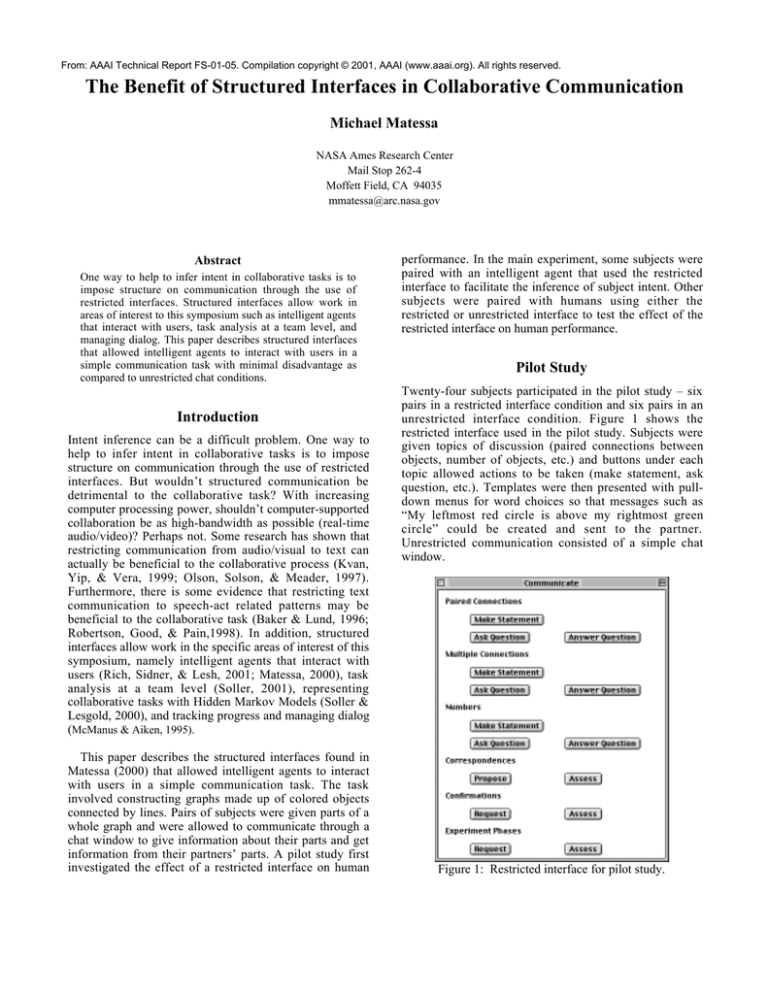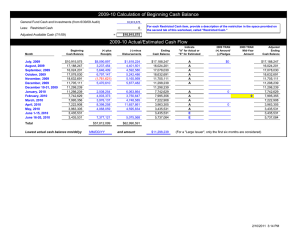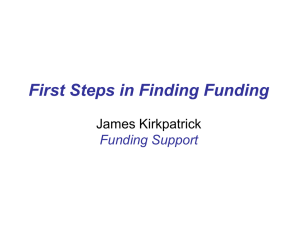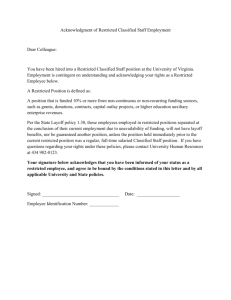
From: AAAI Technical Report FS-01-05. Compilation copyright © 2001, AAAI (www.aaai.org). All rights reserved.
The Benefit of Structured Interfaces in Collaborative Communication
Michael Matessa
NASA Ames Research Center
Mail Stop 262-4
Moffett Field, CA 94035
mmatessa@arc.nasa.gov
Abstract
One way to help to infer intent in collaborative tasks is to
impose structure on communication through the use of
restricted interfaces. Structured interfaces allow work in
areas of interest to this symposium such as intelligent agents
that interact with users, task analysis at a team level, and
managing dialog. This paper describes structured interfaces
that allowed intelligent agents to interact with users in a
simple communication task with minimal disadvantage as
compared to unrestricted chat conditions.
Introduction
Intent inference can be a difficult problem. One way to
help to infer intent in collaborative tasks is to impose
structure on communication through the use of restricted
interfaces. But wouldn’t structured communication be
detrimental to the collaborative task? With increasing
computer processing power, shouldn’t computer-supported
collaboration be as high-bandwidth as possible (real-time
audio/video)? Perhaps not. Some research has shown that
restricting communication from audio/visual to text can
actually be beneficial to the collaborative process (Kvan,
Yip, & Vera, 1999; Olson, Solson, & Meader, 1997).
Furthermore, there is some evidence that restricting text
communication to speech-act related patterns may be
beneficial to the collaborative task (Baker & Lund, 1996;
Robertson, Good, & Pain,1998). In addition, structured
interfaces allow work in the specific areas of interest of this
symposium, namely intelligent agents that interact with
users (Rich, Sidner, & Lesh, 2001; Matessa, 2000), task
analysis at a team level (Soller, 2001), representing
collaborative tasks with Hidden Markov Models (Soller &
Lesgold, 2000), and tracking progress and managing dialog
(McManus & Aiken, 1995).
This paper describes the structured interfaces found in
Matessa (2000) that allowed intelligent agents to interact
with users in a simple communication task. The task
involved constructing graphs made up of colored objects
connected by lines. Pairs of subjects were given parts of a
whole graph and were allowed to communicate through a
chat window to give information about their parts and get
information from their partners’ parts. A pilot study first
investigated the effect of a restricted interface on human
performance. In the main experiment, some subjects were
paired with an intelligent agent that used the restricted
interface to facilitate the inference of subject intent. Other
subjects were paired with humans using either the
restricted or unrestricted interface to test the effect of the
restricted interface on human performance.
Pilot Study
Twenty-four subjects participated in the pilot study – six
pairs in a restricted interface condition and six pairs in an
unrestricted interface condition. Figure 1 shows the
restricted interface used in the pilot study. Subjects were
given topics of discussion (paired connections between
objects, number of objects, etc.) and buttons under each
topic allowed actions to be taken (make statement, ask
question, etc.). Templates were then presented with pulldown menus for word choices so that messages such as
“My leftmost red circle is above my rightmost green
circle” could be created and sent to the partner.
Unrestricted communication consisted of a simple chat
window.
Figure 1: Restricted interface for pilot study.
Results
Table 1 shows overall measures of performance in the pilot
study. Performance was similar for both unrestricted and
restricted conditions on measures of turns to solve the
problem, time to solve the problem, and final problem
score.
Unrestricted
mean
turns
time
score
[min,max]
Restricted
mean
[min,max]
21.5
[11,28]
24.7
[12,33]
22.3
[15,34]
28.3
[15,33]
90.0
[60,100]
98.3
[90,100]
Table 1: Overall measures of performance
Table 2 compares the conceptual content of messages sent
with the restricted and unrestricted interface. Pluses
indicate that the restricted interface supported discussion of
particular content. One difference is that subjects took
advantage of the concept of “blank” spaces in rows or
columns that was supported by the restricted interface but
that was not used as much in the unrestricted interface.
Another difference is that subjects talked about being done
with particular phases of the experiment (“I’m done with
my circles”) but this concept was not supported in the
restricted interface.
_______________________________________________
Restricted Restricted Unrestrictd
Interface Pairs
Pairs
(n=6)
(n=6)
Paired Connections
statement
+
83%
100%
question
+
67%
100%
Multiple Connections
statement
+
100%
100%
question
+
50%
67%
row
+
100%
100%
column
+
33%
17%
blank
+
100%
33%
Numbers
total
+
50%
50%
colors
+
67%
33%
row
+
50%
33%
column
+
33%
17%
in row
0
17%
in column
0
17%
Confirmations
explicit
+
100%
100%
sequence plan
0
50%
Experiment Phases
more info?
0
17%
done info
0
67%
end experiment
+
100%
100% __
Table 2: Conceptual content
Main Experiment
Seventy-six subjects participated in the main experiment -eleven pairs in the unrestricted interface condition, sixteen
pairs in the restricted interface condition, and twenty-two
subjects in the intelligent agent condition. Fewer objects
per problem were used than the pilot experiment so that
more problems could be solved. Figure 2 shows the
restricted interface used in the experiment. Subjects were
given topics of discussion and sample sentences
representing speech act types. After choosing a particular
sentence, a template appeared with menu options for legal
words. Words not on the menu were unable to be typed.
Unrestricted communication consisted of a simple chat
window.
Figure 2: Restricted interface for main experiment
Results
Since the problems in the experiment contained fewer
objects than in the pilot study, pairs had time to solve up o
twelve problems. Figure 3 shows the time to solve
problems, grouping problems into triplets. Subjects using
the restricted interface initially took longer to solve
problems compared to subjects using the unrestricted
interface, but this difference disappeared after a few
problems. The pilot study did not show this initial
difference in the time to solve the problem, and this may be
due to the greater number of objects in the pilot study.
Subjects in the pilot study may have become accustomed to
the restricted interface in the greater amount of time
needed to solve the problem with the greater number of
objects compared to the main experiment. In the main
experiment there was no difference in problem errors
between the two interfaces. The restricted interface allowed
intelligent agents to understand the intent of their partners
and to solve the problems in much the same way as human
partners. Results for subjects interacting with agents and
subjects interacting with humans were similar for time to
solve problems and errors in problems. In addition, roughly
half of the subjects interacting with intelligent agents
thought they were working with human subjects (there is
still room for improvement, however, since only 10% of
subjects interacting with human partners thought their
partners were computers)
Time to Solve Problem
References
Baker, M., and Lund, K. 1997. Promoting reflective
interactions in a CSCL environment. Journal of Computer
Assisted Learning. 13(3), 175-193.
Jermann, P., Soller, A., and Muehlenbrock, M. 2001. From
Mirroring to Guiding: A Review of State of the Art
Technology for Supporting Collaborative Learning. In
Proceedings of the First European Conference on
Computer-Supported Collaborative Learning, Maastricht,
The Netherlands.
Kvan, T., Yip, A., and Vera, A. 1999. Supporting Design
Studio Learning: An investigation into design
communication in computer-supported collaboration. In
Proceedings of Computer Support for Collaborative
Learning, Stanford, December 1999
Matessa, M. 2000. Simulating Adaptive Communication.
Ph.D. diss., Dept. of Psychology, Carnegie Mellon Univ.
20
18
16
(min)
12
time
14
8
unrestr
restr
accom
agent
10
6
4
2
0
1-3
4-6
7-9
10-12
problem
Figure 3: Time to solve problems
Conclusions
The structured interfaces shown in this paper allowed
intelligent agents to interact with human subjects in a
simple communication task with minimal disadvantage as
compared to unrestricted chat conditions. Until the problem
of intent recognition in unrestricted communication is
solved, structured interfaces may be a way of including
computer automation in more collaborative communication
projects in the future.
Acknowledgments
This research was sponsored by the Office of Naval
Research under contract number N00014-95-10223 as part
of the author’s doctoral thesis.
McManus, M. and Aiken, R. 1995. Monitoring computerbased problem solving. Journal of Artificial Intelligence in
Education, 6(4), 307-336.
Olson, J., Olson, G., & Meader, D. 1997. Face-to-face
group work compared to remote group work with and
without video. In K Finn, A. Sellen, & S. Wilbur (Eds.),
Video-mediated Communication (pp. 157-172). Mahwah,
NJ: Lawrence Erlbaum Associates.
Rich, C., Sidner, C., & Lesh, N. 2001. COLLAGEN:
Applying Collaborative Discourse Theory to HumanComputer Interaction, to appear in AI Magazine, Special
Issue on Intelligent User Interfaces.
Robertson, J., Good, J. & Pain, H. 1998. BetterBlether: The
design and evaluation of a discussion tool for education.
International Journal of Artificial Intelligence in
Education, 9(3-4), 219-236.
Soller, A.L. 2001. Supporting Social Interaction in an
Intelligent Collaborative Learning System. International
Journal of Artificial Intelligence in Education,12.
Soller, A., and Lesgold, A. 2000. Knowledge acquisition
for adaptive collaborative learning environments. In
Proceedings of the AAAI Fall Symposium: Learning How
to Do Things, Cape Cod, MA.




